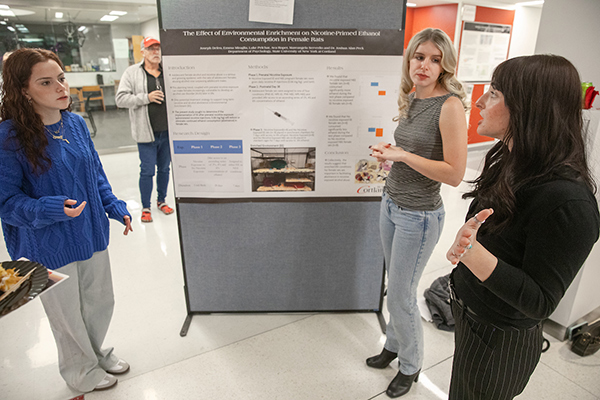
10/07/2025
The 10th annual Michael J. Bond ’75, M.D. Alumni/Undergraduate Research Science Symposium at SUNY Cortland didn’t just bring together students and alums, it united guest speakers that trace a decades-long lineage at the university.
Two of the symposium’s speakers, Janice Edgerly-Rooks ’77 and Michael Wolfin ’11, graduated almost 35 years apart. Yet both found inspiration for successful careers in science thanks in great part to SUNY Distinguished Professor of Biological Sciences Terrence Fitzgerald, who retired last December.
The event, which took place Oct. 24, featured a cross section of graduates speaking to students, along with a lab crawl, student research poster presentations and a planetarium show.
“I would not be working in animal behavior, ecology or entomology if I had not met Terry as an undergraduate,” said Edgerly-Rooks, the Michael and Elizabeth Valeriote Professor in the Biology Department at Santa Clara University. “His approach to science was what I was looking for, without even knowing that was the case. I was hooked almost immediately.”
Wolfin shared a similar connection to Fitzgerald.

While Frank Rossi, professor and chair of the Chemistry Department, was already his chemistry research advisor while he was at Cortland, Wolfin discovered a passion for entomology — the study of insects — in his senior year through Fitzgerald. That set him on his path as a professor at Penn State.
“I was never really interested in insects or entomology before I met Terry and then he just opened up this entire world to me,” Wolfin said. “It opened up this entire tiny world to me that before I didn't know was there.”
The two alums’ paths first crossed just recently when Wolf was interested by a talk Edgerly-Rooks gave at an Entomological Society of America meeting. He later found out she was a fellow Red Dragon, and invited her to give a virtual seminar last year to his students. The Bond Symposium will be the first chance for the two to meet in person.
To Fitzgerald, it’s a pleasure to see two branches of Cortland’s family tree of scientists fulfill their potential — and it serves as an example of what can be achieved.
“Both exemplify how diligence in the studies that our current students are undertaking can lead to extremely successful careers,” said Fitzgerald, who plans to meet with both alums when they come to campus. “That both became entomologists will also serve to show students that career opportunities exist in areas of biology they probably have never previously considered.
“Also, I think that both Janice and Mike will emphasize the importance of going beyond coursework and engaging in original research with a faculty member.”
Dr. Michael Bond ’75, M.D., who retired as the medical director of Advanced Dermatology and Cosmetic Surgery in Orlando, Florida, first funded the annual symposium through an endowment created with a significant planned gift.
In the 10 years since it began as a gathering of some 40 alumni and students in the basement of the Lynne Parks ’68 SUNY Cortland Alumni House, the symposium has grown to a campus event of more than 150 people, celebrating academic excellence as well as student and alumni research in Bowers Hall.
Edgerly-Rooks, Wolfin and fellow speakers Adam Mathews ’07, associate professor of geography at Binghamton University, and Stephanie Grube ’10, an obstetrician-gynecologist and assistant professor at Hofstra University, had a chance to inspire another new generation of Cortland scientists when they returned to campus.
Edgerly-Rooks shared research lessons that were less of a focus when she was an undergrad. Wolfin hopes students walked away from the symposium knowing that they can make a career in the sciences if they stay dedicated.
“I wish there was something like this (when I was a student) where I could talk to other people who have gone into science before me and heard what they learned and learned their lessons,” Wolfin said.
“Work hard, work honestly, and you can do whatever you want,” he added. “I know that sounds cliche, but I would have never imagined that I would be a professor at a research one institution studying the exact same research questions that I did at SUNY Cortland.”